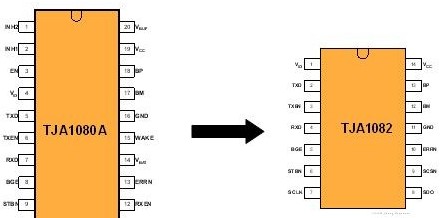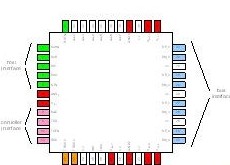NXP FlexRay product line overview
FlexRay's history of development FlexRay network products were born in the late 1990s, when some car manufacturers realized that existing network systems, such as CAN, could not meet the needs of future in-vehicle networks (IVN). These car manufacturers did not develop their own solutions, but decided to form an association to promote the FlexRay communication system to become the industry standard for high-speed communication networks in automotive applications. Based on the leading role in CAN and LIN transceivers at that time, NXP Semiconductors (formerly Philips Semiconductors) was invited to become one of the core partners of the FlexRay Association, responsible for leading the industry in developing the network physical layer.
It took several years to develop a new FlexRay standard, which led to the emergence of various transitional FlexRay technical standards. NXP serves as the leader of the physical layer working group and monitors the progress of the association ’s work as a member of the association ’s steering committee. To enable other members of the association to conduct systematic research on the application of FlexRay, NXP has developed the first hardware solution. This product is called NXP FlexRay TJA1080 transceiver.
At the end of 2006, NXP achieved an important milestone. The first model with FlexRay network was put into mass production: BMW X5. Its active damping control system uses NXP ’s TJA1080 transceiver. Therefore, FlexRay is no longer only in the development stage, but has also entered the mass production stage and has been practically applied.
TJA1080 – the promoter of FlexRay As the world's first chip using FlexRay electrical physical layer, NXP's TJA 1080 proves the powerful performance, flexibility and convenience of FlexRay. This key equipment can provide a wide range of functions, excellent EMC performance and efficient ESD protection, which helps to promote the new advanced communication system into the current and future models.
The main functions of TJA1080 • The data transmission speed in the FlexRay network is up to 10Mbit / s
• Support FlexRay node and active star structure function • ECU low power management • Local and remote wake-up function • Data frame wake-up • Mode control through two dedicated control inputs • Adaptive I / O with VIO input
• Compatible with 42V
• Temperature range: -40 ° C to + 150 ° C
• ± 8kV HBM ESD protection • Error diagnosis and status vector reading
Since TJA1080 was put into mass production, NXP has benefited greatly from market feedback and its own mass production experience. This valuable information helps to identify potential applications for new products, adjust product specifications and functions to meet NXP customer expectations. Of course, NXP ’s transceivers also meet automotive quality and reliability requirements. To achieve this goal, the "Excellent Design" approach was adopted as early as the design development stage.
TJA1080A-Thick and thin market feedback indicates that TJA1080 needs some fine-tuning, but these adjustments are difficult for a mass-produced product, so NXP launched a new model-TJA1080A. At the same time, the FlexRay Association also finalized the first test specification for conformance testing. TJA1080A is tested according to this specification. In November 2007, it became the first FlexRay transceiver that successfully passed the FlexRay compliance test and went on the market.
Compared with its predecessor TJA1080, TJA1080A transceiver has been significantly improved in many aspects:
• Better power reset effect • Fully conforms to Electrical-Physical Layer Specification (Electrical-Physical Layer) V2.1 Rev.A
• Transmit-off circuit can be upgraded to reduce bus radiation • Enhanced receiver circuit-higher RF immunity, ensuring a minimum bit time of 70ns
TJA1080A can be used not only as a node transceiver, but also as a branch of an active star coupler. This makes TJA1080A the most versatile model in the FlexRay transceiver already on the market. To further promote the application of FlexRay, NXP will develop three new and cost-effective products, namely TJA1082 and TJA1081 node transceivers, and TJA1085 active couplers.
TJA1082-Basic Node Transceiver TJA1082 brings together the knowledge and know-how acquired by NXP in developing TJA1080 and TJA1080A. TJA1082 is optimized for the ECU that controls the ignition switch to turn on and off, so it is easy to use and simple to design. Due to functional adjustment, its package size and area are smaller than TJA1080A, and the number of pins is also reduced. The TSSOP14 packaging technology with a size of only 4mm * 6.4mm is also used. This means that the TJA1082 requires only the same PCB space as standard high-speed CAN transceivers (such as TJA1050, TJA1040). TJA1082 fully complies with Electrical-Physical Layer Specification (Electrical-Physical Layer) V2.1 Rev.B

The minimum bit time supported by TJA1082 drops to 60ns. There is also a low-power receiver that can be activated in standby mode. In addition to this, several protection and diagnostic modules are provided: undervoltage detection, bus error detection and temperature protection. This diagnostic information can be transmitted to a microcontroller with a standard SPI interface. TJA1082 can work under the normal 5 volt supply voltage [Clamp15], and can be connected to a variety of voltage microcontrollers. This product will be available in early 2009. Engineering samples are now available, and qualified samples will be ready in early 2009.
TJA1081 – “Clamp 30†node transceiver TJA1081 is compatible with FlexRay EPL 2.1 Rev.A. Similar to TJA1080A, TJA1081 also provides error diagnosis and status register reading function. This new device from NXP is a cost-effective “Clamp30†"The node transceiver has no star structure function and adopts SSOP16 package. TJA1081 can replace TJA1080A in emergency situations. The power consumption of TJA1081 in sleep and standby mode is extremely low. In order to improve the stability of the system, it can support the lowest bit time as low as 60ns. TJA1081 can also manage ECU low power consumption through INH pin.

The product will be available in early 2009. Engineering samples are now available, and qualified samples will be available soon.
TJA1085 – Active node transceiver FlexRay standard supports passive bus topology, topology with source star coupler, and a combination of both. The initial application of FlexRay is a passive bus topology similar to the CAN bus. At the same time, network systems with source star couplers are becoming increasingly important. The multifunctional TJA1080A is used for the first deployment of a star structure. However, in order to form a cost-optimized mass production solution, a dedicated star coupler product is preferred, so TJA1085 star coupler is added to NXP's FlexRay product portfolio. This 4-branch active star coupler will be compatible with the FlexRay EPL V3.0 specification, providing stronger bus error detection, faster error control, and more comprehensive wake-up source status information. At present, there is no similar product on the market that can provide these unique functions.

NXP is currently developing the TJA1085. Samples will be launched in the first half of 2009, and the product is expected to be released in 2009.
TJA1083 – JASPAR compatible transceivers Although many Japanese automotive companies are members of the FlexRay Association, the Japanese automotive industry still believes that the establishment of a domestic association dedicated to the promotion of FlexRay applications can provide certain advantages. Therefore, the JASPAR Association was formally established in 2004, and its members are mainly led by Toyata, Nissan and Hond. To clearly distinguish the difference between FlexRay and JASPAR applications, NXP joined in 2007 JASPAR. Its ultimate goal is to form a solution that is tailored for JASPAR applications and can be perfectly used in it. NXP actively contributes to the JASPAR working group. Given the importance of Japanese automakers, NXP is set up in Japan Various automotive teams have been supported to support these customers.
Due to various measures of JASPAR, Japan has formulated some additional regulations for transceivers. JASPAR is taking further steps: the transceiver's conformance test specification is being written. NXP is planning to launch a FlexRay transceiver optimized for the JASPAR standard. This product is called TJA1083, and once JASPAR draws conclusions around the physical layer and transceivers, this concept will eventually take shape.
NXP's continued contribution to FlexRay NXP is a leader in the IVN transceiver market and a designer of the FlexRay market. It has proved to be a successful mass supplier. Because of its unparalleled record in IVN volume supply, NXP can provide perfect supply security.
To allow customers to easily design and import their products, NXP provides highly reliable system knowledge and fast customer support. For the FlexRay products already on the market, NXP is providing simulation models of transceivers and providing network topology simulations to automotive OEMs.
NXP has witnessed the rapid development of the FlexRay market. More and more OEM manufacturers are beginning to adopt FlexRay technology and incorporate the FlexRay network into automobiles.
NXP's next-generation FlexRay physical layer product will target more powerful functions, further improve EMC and increase integration, thereby optimizing system costs.
Coal Gas Generator Sets, 600KW Coal Gas Generator, 600kw Gas Generator,Coal Gas Generator Set 600KW
Jinan Guohua Green Power Equipment Co.,Ltd. , https://www.guohuagenerator.com